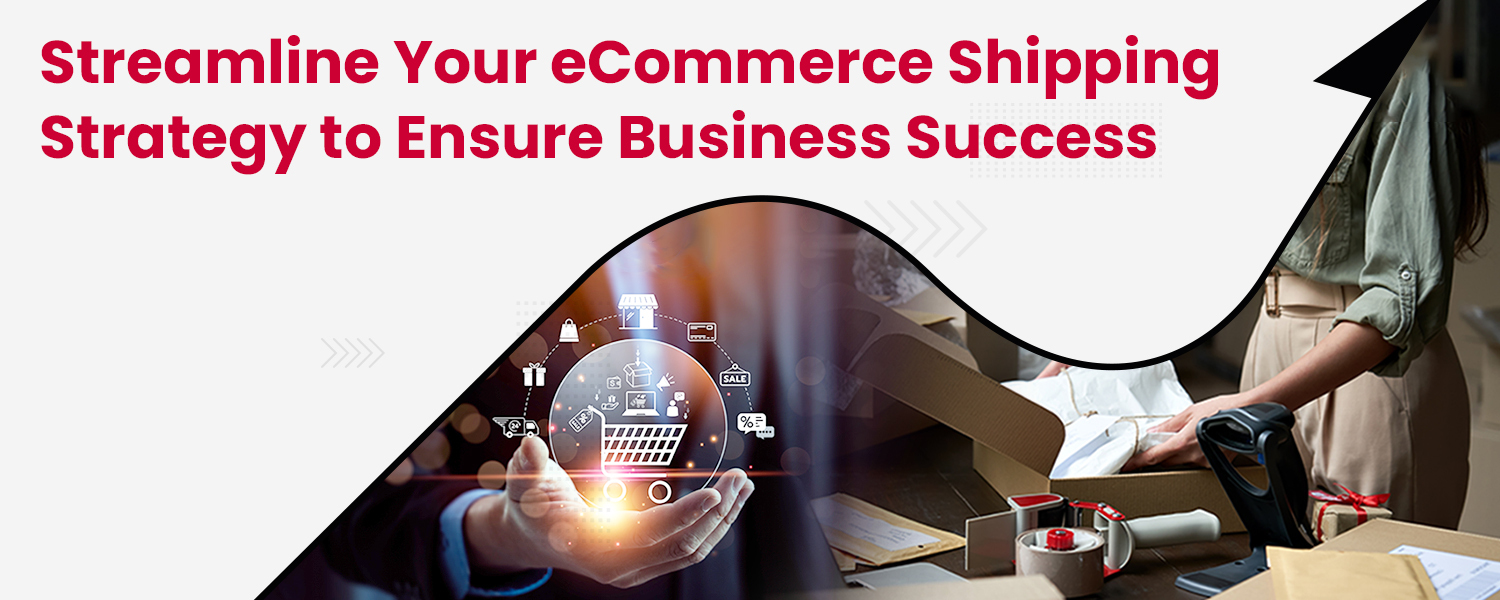Global eCommerce sales are expected to soar beyond $6.3 trillion by the end of 2023. Behind each click, cart addition, seamless transaction, safe deliveries, shipping and logistics power the entire process. Today, the expectations behind the scenes are monumental. Customers desire prompt deliveries, impeccable packaging, and the flexibility to return or exchange with ease.
And businesses? They’re racing against time, managing inventories, choosing carriers, and constantly optimizing to balance cost and customer satisfaction.
Now, if you’re wondering why there’s so much ado about shipping, let’s delve deeper. A robust eCommerce shipping strategy is the lynchpin that can make or break a business in this digital age. In this blog, we’ll discuss the layers of this strategy, understand its nuances, and discover ways to streamline it.
How eCommerce Delivery Works
When a customer clicks the ‘buy now’ button, that action sets off a chain of events, starting with the order placement. This initial step is where the customer selects their desired product, adds it to their virtual cart, and confirms the purchase after entering their payment and delivery details. The system then processes the order, verifying the transaction’s validity.
But here’s where the real behind-the-scenes begins. Once the order is confirmed, it reaches the seller, who must prepare the product for dispatch. Depending on the business’s scale and sophistication, this can mean a manual check by an employee or an automated system pulling the product from the warehouse shelves. Precision is paramount at this stage, ensuring that the right product, in the right size or variant, is packed for the awaiting customer.
Once the product is packaged, the seller hands it to a carrier or logistics provider responsible for the transportation phase. This choice could range from global giants like FedEx or DHL to regional carriers specializing in specific geographies.
These providers use technology, manpower, and transportation means (vans or bikes) to ensure timely and safe delivery. Advanced tracking systems inform sellers and customers of the package’s journey, offering real-time updates and estimated delivery times.
However, the loop doesn’t close upon the package’s arrival at the customer’s doorstep. Instead, the role of the customer becomes pivotal. Their experience receiving the package, evaluating the product, and determining if it meets their expectations can lead to potential returns or exchanges. This feedback loop is crucial for sellers, as it provides invaluable insights into product quality, delivery efficiency, and areas of potential improvement.
Why is Shipping so Important for eCommerce?
The Lifeline of eCommerce Operations
In today’s fast-paced digital market, shipping isn’t just a mere back-end operation; it’s the lifeline of eCommerce ventures. This is because eCommerce, at its core, is about buying products online and having them delivered physically. Therefore, the shipping process effectively bridges the digital act of purchasing with the tangible experience of holding and using a product. This transition from the virtual cart to a physical product at one’s doorstep epitomizes the role of shipping in online business operations.
The Direct Link: Shipping and Customer Satisfaction
Imagine a scenario where a customer orders a product, only to arrive late or damaged. Such poor shipping experiences can instantly erode trust and satisfaction. Conversely, punctual and accurate deliveries not only meet but can exceed customer expectations, creating an immediate sense of trust and reliability with the brand.
Shipping as a Conversion Tool
Research shows that one of the primary reasons for cart abandonment is unexpected or high shipping costs. Businesses can significantly reduce cart abandonment by offering transparent shipping rates and various options. For instance, when an eCommerce platform introduced multiple shipping options tailored to customer needs, there was a notable surge in conversion rates. This reflects the direct impact of strategic shipping on purchase decisions.
Cost-efficiency vs Speed
Businesses often find themselves at a crossroads between offering cost-efficient shipping and meeting the growing customer demand for rapid deliveries. While expedited shipping can be expensive, there’s a rising demand for same-day or next-day deliveries, especially in urban areas. Businesses must find the perfect balance, optimising their operations to provide quick deliveries without excessive costs. This might involve using local warehouses or partnering with multiple carriers to find the best rates.
Understanding eCommerce Shipping Challenges
Evolving Customer Expectations and the Demand for Faster Delivery
eCommerce has revolutionised the way we shop, but it has also radically shifted consumer expectations. Fulfilling these expectations requires meticulous logistics, strategic warehousing, and robust supply chain management, not to mention considerable resources. As traditional retailers pivot to online models, they often find themselves racing to match these accelerated delivery promises, sometimes at the risk of operational inefficiency.
Inventory Mismanagement Risks
At the heart of eCommerce lies inventory management. Real-time inventory tracking is crucial to prevent overstocking (leading to unwanted storage costs) and understocking (leading to lost sales). Inaccurate inventory levels can erode customer trust, especially if products listed as available are out of stock.
Challenges in Last-Mile Delivery
While it might seem like a mere final step, last-mile delivery is fraught with challenges. Densely populated urban areas pose traffic challenges, while remote rural areas might lack proper addresses. Balancing timely deliveries with sustainable and cost-effective methods is tricky.
Issues with International Shipping, Including Customs and Regulations
Global business can be lucrative, but international eCommerce shipping is complex. Dealing with customs laws, tariffs, and import restrictions can be daunting. Additionally, ensuring product compliance and handling international returns and exchanges amplifies the challenge.
How Your eCommerce Shipping Strategy Affects Business Success
Choosing the Right Shipping Carrier
Shipping carriers are the silent partners in your eCommerce journey. Choosing between major carriers versus regional options involves weighing reliability, speed, coverage, and cost. Understanding their pricing structures, especially regarding volume discounts or peak season surcharges, can significantly impact your bottom line and customer satisfaction.
Packaging Strategies for Safe Transit
A product’s journey, from a warehouse shelf to a customer’s hands, is filled with potential hazards. Protective packaging ensures products arrive intact and as expected. However, the modern consumer also values sustainability. Eco-friendly packaging options can elevate brand perception. Moreover, unique branding on packaging can turn ordinary shipments into memorable unboxing experiences, further enhancing brand loyalty.
Automating Order Fulfillment
Automation is the linchpin of efficiency in eCommerce. By leveraging the best shipping software for eCommerce, businesses can drastically reduce manual errors, ensuring the right products reach the right customers. Integrating eCommerce platforms with logistics systems can facilitate real-time tracking and communication, keeping customers informed and engaged.
Optimal Inventory Management
A well-oiled inventory management system is at the core of every successful eCommerce venture. Balancing the act between overstocking and stockouts is crucial. Modern technology aids in predicting demand, ensuring timely restocking, and minimising storage costs.
Personalization in Shipping Experience
In the age of personalized marketing, why should shipping lag? Tailoring delivery options based on customer preferences or adding personal touches like notes or branded packaging can significantly elevate the customer experience, setting your brand apart in a crowded market.
Return and Exchange Handling
A straightforward, hassle-free return policy can be the deciding factor for many online shoppers. Ensuring easy return processes boosts immediate sales and aids in long-term customer retention by building trust and goodwill.
Navigating International Shipping Challenges
Going global comes with challenges, from understanding diverse customs, duties, and regional regulations to mitigating potential shipping delays and issues abroad. Being proactive and knowledgeable can help businesses traverse this complex terrain with ease.
Monitoring and Optimisation
Lastly, continuous monitoring through data analysis allows businesses to gauge their shipping performance. Feedback loops with both carriers and customers offer invaluable insights. This iterative monitoring, feedback, and optimization process ensures that businesses stay agile, adaptable, and, most importantly, customer-centric.
Conclusion
A robust and streamlined eCommerce shipping strategy acts as the bridge connecting your business’s promise to its delivery, quite literally. But remember, while you might have a strategy that works wonders today, the eCommerce industry is ever-evolving, driven by technological innovations and shifting consumer expectations. So, let today’s strategy be the stepping stone, not the final destination. Invest in platforms like NimbusPost, which can give you an upper hand over the competition, facilitating you with the best eCommerce shipping company recommendation, warehousing and fulfillment, bulk shipping, and much more.
FAQs
How can I reduce shipping costs without compromising service quality?
To reduce shipping costs without compromising service quality, you can implement several effective strategies:
Optimise Packaging: Efficient packaging can help reduce shipping costs. Use appropriately sized boxes or packaging materials to avoid wastage and dimensional weight charges.
Negotiate with Carriers: Negotiating shipping rates with carriers can lead to significant cost savings.
Utilise Shipping Aggregators: Shipping aggregators like NimbusPost act as intermediaries between suppliers and users, leveraging their scale and user experience to secure better rates from shipping carriers.
What are the benefits of integrating an Order Management System (OMS) in eCommerce shipping?
Integrating an Order Management System (OMS) in eCommerce shipping offers several benefits. Here are some key benefits:
- An OMS with API integration capabilities helps streamline complicated processes in eCommerce shipping.
- An OMS provides real-time visibility into inventory levels across multiple channels and warehouses.
- With an OMS, you can track orders at every stage of the fulfilment process.
- Integrating an OMS enables a seamless customer experience by automating order processing, shipping, and delivery.
How can I handle returns and exchanges efficiently?
To handle returns and exchanges efficiently, you can follow several best practices:
- It is crucial to have clear return and exchange policies. This helps set expectations for your customers and provides them with a transparent process.
- Provide your customers with multiple options for returning or exchanging products.
- Use technology and automation to streamline the returns and exchanges process. Implementing an automated system can help you track and process returns more efficiently.
What are the best practices for international shipping?
Some of the best practices for international shipping are as follows:
- Understand customs, duties, and regulations specific to the destination country to ensure smooth delivery.
- Partner with carriers that have a strong track record in international shipping and offer tracking services.
- Clearly communicate potential customs fees and taxes to customers to prevent unexpected costs.
- Ensure packaging is sturdy enough to withstand longer transit times and multiple handling points.
- Knowledge of bilateral/multilateral trade agreements can offer cost benefits.
- Ensure international customers understand the return process and costs involved.
- Each country may have specific restrictions; staying updated helps avoid shipment delays.
- Use shipping software solutions to simplify the process, provide real-time updates, and enhance customer experience.



